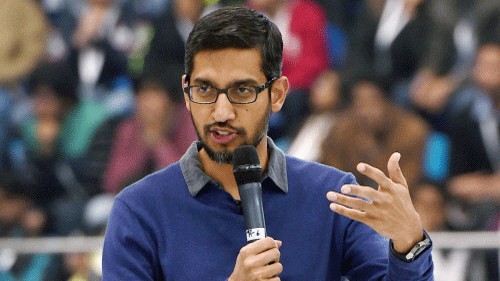
Google CEO Sundar Pichai.
Credit: PTI Photo
By Parmy Olson
Alphabet Inc., the parent company of Google, is inching its way toward a healthier, diversified business model. That might not have seemed so obvious on Wednesday, when shares in the company dropped after it revealed that advertising sales had fallen below expectations in the fourth quarter.
But its efforts to break a longtime addiction to the ad business are moving in the right direction. Subscription revenue from services like YouTube and cloud-storage product Google One were up and taking larger slices of the revenue pie, while ad sales declined to their lowest proportion in years.
Over time, Google would do well to eventually look as diversified as Microsoft Corp., but it could be a rough transition as the company tries to use its artificial intelligence expertise to serve three very different customer bases.
Let’s start with the good news: Google is gradually relying less on the ad business that made it the goliath it is now. Being so exposed has made it vulnerable to an array of economic speedbumps like rising interest rates, and with all its consumer privacy infringements, targeted advertising is one of Big Tech’s most ethically dubious enterprises.
Having derived about 80 per cent of its revenue from advertising back in 2020, that figure has gradually declined in the years since, hitting 76 per cent in this latest quarter as subscriptions and cloud services took up larger shares of sales.
Alphabet Chief Executive Officer Sundar Pichai couldn’t have picked a more meaningful time to grow Google out of its ads and search operations.
Though its ubiquitous search bar has been a cash cow and dominated the internet for years, its future looks more uncertain than ever thanks to flourishing generative AI tools like ChatGPT, Claude and Perplexity, which are being touted as helpful, less ad-heavy alternatives.
So far, Google’s diversification efforts seem to be working. Its subscription-based products, which barely got a mention in the company’s 2020 earnings, now bring in nearly 13 per cent of revenue, up from 11 per cent last year.
And though Google’s market share in the cloud segment is much smaller than that of Amazon.com Inc. or Microsoft, margins for this business came in above analyst expectations — an impressive feat given AI services are so expensive to run.
Google is in an enviable (and arguably incestuous) position to solve that problem. Though it has to spend a lot of money on chips and servers to power its AI offerings — sending its capital expenditure soaring by almost Rs 24,910 crore ($3 billion) this past quarter — it also sells the costly cloud services that other firms who make AI software are so hungry for right now.
But making the transition into other fruitful businesses will be a strategic challenge for Pichai. For most of its lifetime, Google’s number one customer has been advertisers, and the fruits of its research and development efforts have been funneled into keeping them highly satisfied.
Now Google is learning to serve two others, growing masters: the corporate customers buying its cloud products (which brought in Rs 74,722 crore ($9 billion) in the last quarter) and consumers purchasing subscriptions to YouTube Premium, Google One, and soon, its ChatGPT rival Bard Advanced.
Spending heavily on AI to impress advertisers, enterprises and consumers gives Google a more complex customer mix compared with a company like Microsoft, which primarily concentrates on enterprises and consumers.
Google will need to ensure that as its smarter algorithms make advertising even more targeted and effective, they don’t also compromise the user experience of consumers.
Sure, if the ads become too intrusive, that could drive more consumers to Google’s ad-free services such as YouTube Premium and Bard Advanced.
That’s great for those businesses, but not so much for the advertisers. And Google will meanwhile have to differentiate between what it can offer consumers and what even-better AI tools it can sell to enterprise cloud customers.
Google has found itself in a position where it’s trying to sell clever AI tools to everyone in a tricky balancing act that the company has never played before.
It must weigh their very different needs while ensuring that its products are worth the money, without compromising their trust. So far Sundar Pichai is pulling it off, but it will be an uphill climb into very new territory.